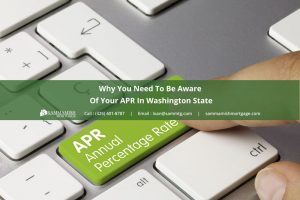No Obligation and transparency 24/7. Instantly compare live rates and costs from our network of lenders across the country. Real-time accurate rates and closing costs for a variety of loan programs custom to your specific situation.

We’ll start by asking what the difference is between the APR and the interest rate on a mortgage, as they are not the same thing.
The interest rate on a mortgage and not the APR is how your payment is calculated. The interest rate is the percentage of the loan amount you will pay in addition to the principal each year, and it is expressed as a percentage and is quoted annually. The APR (Annual Percentage Rate) is a broader measure of the cost of a mortgage that includes the interest rate as well as specific other fees such as discount points, origination fees, all lender fees, some third-party closing costs, and other prepaid or financed charges. The APR is designed to help borrowers compare the actual price of different mortgage loans by considering the various fees included in the loan.
APR, or annual percentage rate, is an important factor to consider when shopping for a mortgage. It represents the cost of your loan by taking into account the interest rate and other fees and closing costs associated with it. APR is not the same as your interest rate, as it includes additional expenses such as origination fees or points. The Truth in Lending Act requires lenders to disclose the APR to borrowers so they can make an informed decision about their loan.
It’s important to note that not all fees are included in the APR — they’re not required to include certain costs such as credit reporting, title insurance, appraisal and inspection fees. To get an accurate understanding of how much each loan will cost, ask your mortgage lender what is and isn’t included in the APR when comparing offers. Knowing this information can help you make a more informed decision about which loan is best for you.
To calculate the APR on a mortgage, you need to add the applicable APR fees to the loan amount and then divide that number by the loan amount. The resulting percentage is the APR. Generally, the APR is higher than the interest rate because it includes the APR fees paid at closing. However, it is essential to note that the APR does not include all the fees associated with a mortgage, such as many third-party fees, property taxes, homeowner’s insurance, or HOA fees (homeowners association).
An interest rate is the amount of money charged by a lender to a borrower for the use of their money. It is expressed as a percentage of the loan amount and is usually paid periodically over the life of the loan. Interest rates can vary greatly depending on factors such as the type of loan, credit score, and current market conditions.
Fixed-rate mortgages are loans with an interest rate that remains constant throughout the life of the loan. This means that borrowers will pay the same amount each month regardless of changes in market conditions. Adjustable-rate mortgages (ARMs) have an interest rate that can change at certain intervals based on market conditions. ARMs typically start out with lower rates than fixed-rate mortgages but can increase or decrease over time depending on market fluctuations. Borrowers should be aware that if interest rates rise, their monthly payments may also increase significantly.
The APR and interest rate are both important tools for comparing different loans. The main difference between them is that the APR includes additional fees associated with getting a mortgage, such as origination fees and other costs. For example, if a lender offers a 30-year fixed-rate mortgage for a $350,000 home with a 20 percent down payment and an advertised interest rate of 5 percent, the borrower may also have to pay an origination fee of 1 percent and some other fees that add up to $800. This would make the APR 5.111 percent.
It is important to understand the difference between APR and interest rate when considering different loan options. While the interest rate may be lower than the APR, it does not include all of the associated costs that come with getting a mortgage. Knowing this can help you make an informed decision when selecting your loan option.
In summary, the interest rate is the percentage of the loan amount you will pay in interest each year, while the APR is a broader measure of the total cost of a mortgage that includes the interest rate and specific fees. It is essential to consider both the interest rate and the APR when shopping for a mortgage, as the APR can give you a more accurate picture of the total cost of the loan.
The Annual Percentage Rate (APR) of a loan is higher than the loan’s interest rate because it takes into account multiple costs associated with borrowing. The interest rate of a loan simply describes the rate at which interest will accrue on the balance, but APR takes this into account and adds additional fees that you have to pay. These may include origination fees, closing costs, and other charges associated with obtaining the loan. Because these additional costs are added to the interest costs, APR will be higher than the simple interest rate.
It is important to understand that APR is not just an indication of how much you will pay in interest over time; it also includes any other fees or charges associated with taking out a loan. Knowing your APR can help you compare different loans and make sure you get the best deal possible. It is also important to remember that while APR may be higher than the simple interest rate, it does provide a more accurate picture of what your total cost of borrowing will be over time.
Comparing APRs is an important tool for evaluating mortgage offers, but it’s not the only factor to consider. The APR (Annual Percentage Rate) is a regulatory tool that helps protect consumers from misleading advertising. It’s required by Federal Regulation Z, also known as the Truth in Lending Act, and lenders must disclose a loan’s APR when they advertise its interest rate. This makes it easier to compare different lenders and determine which one has the best deal overall.
If you are shopping for a mortgage or comparing interest rates from different lenders and the only information you have is the interest rate and the APR, looking at the difference between the rate and the APR can be helpful to get a ballpark idea of the lender fees associated with the offer. For example, if you have an interest rate of 6.000% and an APR of 6.400%, it’s safe to assume many upfront fees are included in that offer. If another lender is quoting 6.000% with an APR of 6.051%, you can assume this offer will have significantly lower fees than the first option. When comparing, you need to make sure both programs are the same. For example, in this situation, both offers are for a 30-year fixed mortgage.
When you receive a loan estimate from a lender, page 3 of the document will show you the loan’s APR. By comparing loan estimates (mortgage offers), you can easily compare APRs and make sure you are getting the best deal possible. However, it’s important to remember that there are other factors to consider when evaluating mortgage offers such as fees and closing costs. Taking all these factors into account will help ensure that you get the best mortgage for your needs.
Comparing the APR of two mortgage offers can be a helpful way to reach the total cost of different mortgage loans and determine which one is the best deal if that is the only information you have; however, looking at the APR on its own can be highly misleading and it is essential to note that the APR is not the only factor to consider when shopping for a mortgage.
APR is only an accurate reflection of the total costs of a loan reflected in an annual percentage rate if you keep the loan for the entire term. In the two scenarios above, it’s easy to see that the second choice with a much lower APR at the same rate is the better option; however, if you compare one option at 6.000% with a 6.400% APR and another chance at 6.500% with a 6.515% APR you would assume the first option with a lower APR is the better choice…correct? Well, it depends on how long you keep the mortgage because, as mentioned above, the APR reflects the total costs of the loan calculated out over the entire term, which is 30 years. If you sell your home, refinance the mortgage or pay off your mortgage early, the APR calculation is no longer valid as the duration of the loan changed, yet the upfront costs are not refundable.
In this example, we assume the purchase price of the home is $500k with a 20% down payment on a 30-year fixed:
** The numbers below do not reflect today’s rates and are used solely as an example. If you want to see current rate and costs options visit our Instant Rate Quote tool.
In the option above, without taking into consideration the time value of money and other factors an experienced Mortgage Advisor will look at before advising a client on the best option, #1 would be the better option if you kept the mortgage for the entire term of 30 years; however, historically less than 1% of borrowers in the US own their loans for 30 years.
If you keep your loan for an average of 5-7 years, option #2 would be a much better option as it will take a lot longer than 5-7 years of the lower payment at 6.000% to compensate for the approximate $16,000 in additional upfront fees. Add to that the opportunity costs of paying the $16,000 to get a lower rate instead of investing that money, and option #2 looks even better.
When comparing offers with different rates and fees, it can become challenging to figure out which option is best on your own. In an ideal world, you would have an experienced Mortgage Advisor you trust who can walk you through the options and determine the best rates and fees based on your plans.
Thankfully, there are now many convenient and cost-effective solutions available – such as online marketplaces – that can take the complexity out of finding the best deal. These solutions allow you to compare mortgages side-by-side in order to make an informed decision on which option is right for you. When searching lenders on rate tables it is important to know that the companies that run the tables do very little if any due diligence on the lenders that advertise with them. The vast majority of online marketplaces do not verify the accuracy of the rates posted on their websites. Even reputable marketplaces that have policies requiring lenders to only advertise real rates a consumer can lock have a tough time enforcing this and have a conflict of interest given the lenders are their true customer, not the user.
We consistently compete with lenders on some of the biggest online rate tables that intentionally advertise misleading rates and try to find ways to change the terms once they have the consumer committed. I’ve also seen those same lenders accumulate a significant number of bad reviews only to have those bad reviews removed from their listing. Bottom line is due your due diligence when considering a lender on a rate table. Look up that lender through Google and see what kind of reputation they have outside of where you found them. A reputable lender will have a solid presence from a variety of online sources, not just in places they pay to be seen.
Pro Tip: If the lender you are considering does not have transparent rates and closing costs easily found on their main website that is a red flag. What are they hiding and why don’t they make it easy for consumers to see what they can offer.
Ideally you are working with lenders that provide quotes without much of a hassle. If you are comparing multiple quotes from different lenders and you want to simplify it for yourself as much as possible. Pick an option from one lender you like and then request quotes from the other lenders using the same rate. For example, if you have a selection from Lender A with a rate of 6.25% that you think is a good option, then request quotes from the other lenders at the same rate of 6.25% on the same loan program. Once you compare the same rate and loan program, you can compare lender fees to see which offer is the “best.”
When comparing fees, I recommend only comparing lender fees and not the total closing costs, including prepaid items. Why? When getting a mortgage, especially a purchase, most third-party fees, property taxes, and homeowner’s insurance premiums are not controlled by the lender and will be the same or similar regardless of the lender you work with. Additionally, third-party fees are easily manipulated, and lenders can play games quoting artificially low numbers. For example, a lender may repeat a really low title and escrow company they own or are affiliated with even though, on purchase, your Purchase Agreement already specifies the title and escrow company that has to be used to close the loan. The title and escrow fees will be the same regardless of which lender you work with and what they quote.
This is especially true for prepaid items such as property taxes, homeowner’s insurance, and daily interest. These will be the same regardless of which lender you work with and are determined by which day of the month you close and what your specific property taxes and homeowner’s insurance premiums are. Some lenders will drastically under-quote these items to make the cash due at closing, and total closing costs look good upfront, but later in the process, the numbers will adjust and reflect reality, and by that time, it’s too late to switch lenders.
The easiest way to compare lender fees is to look at all Origination Charges, shown in Section A of an official Loan Estimate. If you don’t have an official Loan Estimate, look for the following and add them up. Discount Points, Origination Fees, Processing Fees, Admin Fees, Underwriting Fees, and Doc Prep Fees. Some creative lenders may figure out another way to classify a lender fee, so if you have questions, ask.
This can be confusing, which is one reason we at Sammamish Mortgage do not charge any lender fees. The only lender fees our borrowers pay are if they buy down the interest rate in the form of Discount Points which is interest that a borrower can pay upfront to lower the interest rate on their mortgage.
Getting an honest second opinion when you get a Loan Estimate can save you thousands of dollars when getting a mortgage. This is something I would recommend to anyone getting a mortgage, even if you are getting a second opinion when working with us.
In summary, while comparing the APR can be a helpful way to compare rates if that’s the only information you have, there is a lot more to consider when shopping for a mortgage to make sure that the loan you choose is the right fit for your financial situation. Working with an experienced and trusted Mortgage Advisor who will help determine a strategy and long-term plan based on your specific financial dreams and goals is essential to maximizing wealth through real estate. Don’t trust the most significant financial decision you’ll ever make to a random Call Center Loan Officer that just came out of 6 months of training and can barely spell mortgage.


Whether you’re buying a home or ready to refinance, our professionals can help.
{hours_open} - {hours_closed} Pacific
No Obligation and transparency 24/7. Instantly compare live rates and costs from our network of lenders across the country. Real-time accurate rates and closing costs for a variety of loan programs custom to your specific situation.